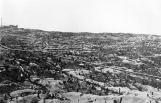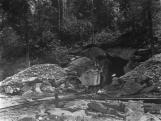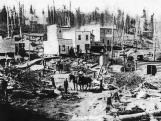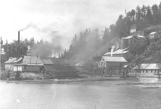1
Historical Records Surface ViewsSilver was discovered at Long Lake in 1903, when the Timiskaming and Northern Ontario Railroad was under construction to service the Claybelt agricultural area. Exploratoion and mining very quickly changed the horizon from
that of Boreal forest to a bustling industrial site. Environmental concerns weren't considered in the early days as mines were started wherever silver veins were encountered. At one point there were 106 mines on record. These were staked but not all actively mining. Millions of ounces of silver were mined in the Cobalt Mining Camp from underground, from hillsides and from lake bottoms throughout the ensuing years.
NOTE:
Click on the picture to see an enlarged view of any picture throughout the exhibit.
3
Nipissing Mine AditWhere there no exposures of silver veins visible on the rock outcrops and the miners and prospectors were sure that they were close by, 'adits' or tunnels were driven into the hill sides so that the veins could be discovered. Cobalt was ideal for this type of mining and exploration due to the many rocky outcrops and hillsides in the area of the silver veins. In the initial stages, broken rock was loaded into a mine car and pushed out by hand from the underground to open air. If a silver vein was encountered, the material was hand sorted for values at the adit entrance. The mine cars usually had a capacity of about one ton of broken rock and ran on a small gauge rail line.
4
Trenching - Nipissing Mine1910
Cobalt Mining Camp, Town of Cobalt and Coleman Township, Ontario, Canada

5
Trenching - Nipissing MineMuch of the countryside around Cobalt was covered with glacial deposits of sand and clay. Jack pines, poplars and birch grew in the area, depending on the soils. This material had to be removed to find the silver veins that would be exposed on surface. Initially these were found by digging trenches through the soil and overburden to the rock below. The area looked like a checker board after it had been prospected in this way.
Prior to trenching, all the trees would have been cut for construction, firewood or for mine support purposes. This method of exploring was very labour intensive and was replaced by using hydraulic monitors to wash the overburden off into the adjacent lakes. There was very little concern with regards to environmental matters at this time.
7
Hydaulic MonitorsInitially prospecting on hill sides was done by trenching the overburden and examining the bed rock. This was a slow labour intensive method. The mine owners decided that a much quicker method would be to install water pumps at the closest lake and use hydraulic monitors to wash the overburden off the rock surfaces. This was successfully done at several mines in the area. It proved to be a successful method and new silver veins were located. On a historical basis this method of using water to clean hill sides was used in England to locate lead veins in medieval times.
9
Nipissing MineThe Nippissing Company, incorporated in 1904, bought 846 acres which had first been claimed, in 1903, as farm lots for fifty cents an acre. This claim ran from Bucke Township along the eastern edge of Cobalt Lake and encircled Peterson and Cart Lakes. Almost a million ounces of silver were produced by the late 1930's.
11
Early StructuresThere were no facilities available at all in the Cobalt area when silver was found. There were settlements at Haileybury and New Liskeard some five and eight miles away respectively. Due to traveling distances involved this meant that structures had to be built from scratch. Flat ground in the area was at a premium. Houses, boarding houses, businesses and eventually stores and banks were all built in a somewhat random pattern amongst the mines as they were found.
14
Cobalt Lake MineAfter Sir Henry Pellat purchased the mineral rights for 47 acres under Cobalt Lake, the water was pumped from Cobalt Lake into Cross Lake. In 1915 a profitable vein was uncovered in the reverse fault under Cobalt Lake.





